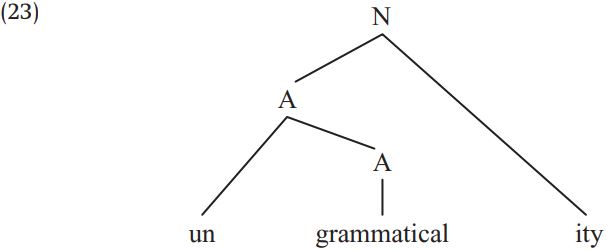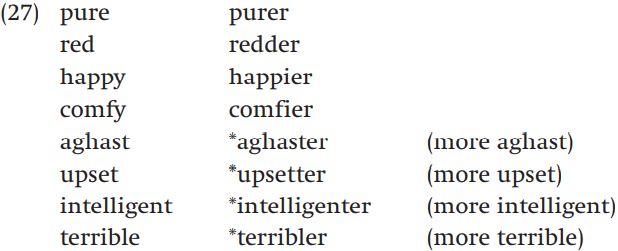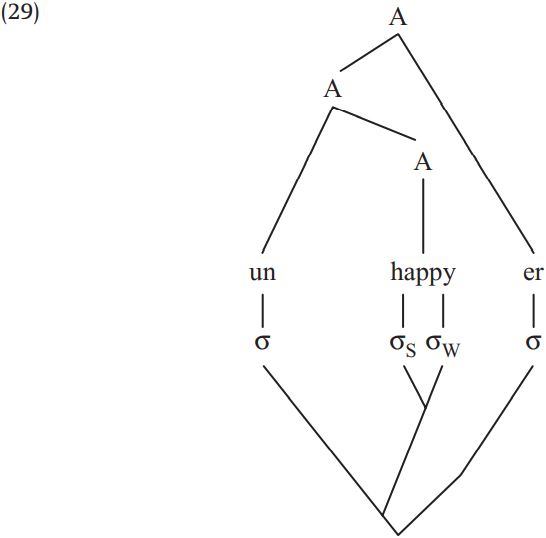


 Grammar
Grammar
 Tenses
Tenses
 Present
Present
 Past
Past
 Future
Future
 Parts Of Speech
Parts Of Speech
 Nouns
Nouns
 Verbs
Verbs
 Adverbs
Adverbs
 Adjectives
Adjectives
 Pronouns
Pronouns
 Pre Position
Pre Position
 Preposition by function
Preposition by function 
 Preposition by construction
Preposition by construction
 Conjunctions
Conjunctions
 Interjections
Interjections
 Grammar Rules
Grammar Rules
 Linguistics
Linguistics
 Semantics
Semantics
 Pragmatics
Pragmatics
 Reading Comprehension
Reading Comprehension|
Read More
Date: 2023-08-17
Date: 2024-02-05
Date: 2023-08-31
|
Bracketing paradoxes
Bracketing paradoxes are cases in which either the semantic interpretation or the phonological organization of a word seems to conflict with its internal structure. Consider the words in (22):

At first glance, these are unremarkable words. But if we look more closely at them, you’ll see that they raise some problems. The word ungrammaticality needs to have the structure in (23):

Since the prefix un- attaches to adjectives and does not change category, it must attach first to the base grammatical. 6 The suffix -ity attaches to adjectives and forms nouns. So the structure in (23) would be justified according to the structural requirements of the affixes. But un- is a native prefix, and -ity a non-native suffix. The structure in (21) therefore requires that a native prefix go inside a non-native suffix, In other words, if there really is some sort of constraint against non-native suffixes appearing outside native suffixes, the word ungrammaticality is paradoxical.
Of course, this example may not be such a problem after all, since – as we saw above – there are other cases in which a non-native affix appears outside of a native one. The word blue-eyed, however, is paradoxical in a way that cannot be attributed to stratal ordering. It appears to be a compound of the adjectives blue and eyed, the second of which is itself a complex word consisting of the noun eye and an adjective-forming suffix -ed:

But the structure in (24) implies that there is an independent adjective eyed and that seems not to be the case. Besides, the word blue-eyed seems to mean ‘having blue eyes’, which would suggest the structure in (25), rather than the one in (24):

How do we explain this paradox? In fact, a number of solutions to this paradox have been suggested. The most plausible is that the structure in (24) is in fact correct, and that there is a pragmatic reason why we don’t find an independent word eyed. We don’t find such a word because it’s usually not a useful concept. People assume that living organisms have eyes, so we’d never have a reason to point out the ‘eyed one’ as opposed to the one without eyes. But given a context in which such a contrast is plausible – say, comparing two space aliens – it no longer seems so absurd to think of an independent word eyed.
Our final example of a bracketing paradox is the word unhappier, which is paradoxical for yet a different reason. Here, the semantic interpretation of the word would suggest the structure in (26):

The word unhappier seems to mean ‘more unhappy’, with the comparative suffix -er applying to the negated adjective, so the semantic interpretation of the word corresponds to this structure. However, the comparative suffix -er has a phonological restriction on its attachment that calls the structure in (26) into question. Consider the forms in (27):

The comparative suffix attaches to one-syllable adjectives, and to two syllable adjectives whose second syllable is unstressed. Two-syllable adjectives whose stress falls on the second syllable (for example aghast or upset) cannot take the comparative -er suffix, but have only the periphrastic comparative (more aghast, more upset). And three-syllable adjectives never form their comparatives with -er. The problem with the structure in (26), then, is that -er looks like it has attached to the complex adjective unhappy, which consists of three syllables. Of course, if the -er were first attached to happy and then un- attached outside that, as in (28), there would be no problem:

But this does not accurately reflect the meaning of the word. The structure in (28) suggests that the word means ‘not happier’ rather than ‘more unhappy’.
Here too, there is a potential solution to the paradox. Many morphologists believe that words have two separate structures, one which reflects the syntax and semantics of the word, and a separate structure which reflects the prosodic organization of the word into syllables, feet, and higher levels of phonological organization. We will not go into the details of different levels of phonological organization here, but I can give you just a suggestion of what I mean. Suppose that the word unhappier has two simultaneous structures:

The top structure is identical to the one in (26) and reflects the semantic organization of the word. The one on the bottom reflects the phonological organization of the word, where σ stands for ‘syllable’, σS for ‘stressed syllable’ and σW for ‘unstressed syllable’. If words are allowed to have two separate and simultaneous representations, one for their syntactic and semantic structure, and another for their phonological structure, the word unhappier is no longer paradoxical.
|
|
|
|
"عادة ليلية" قد تكون المفتاح للوقاية من الخرف
|
|
|
|
|
|
|
ممتص الصدمات: طريقة عمله وأهميته وأبرز علامات تلفه
|
|
|
|
|
|
|
ضمن أسبوع الإرشاد النفسي.. جامعة العميد تُقيم أنشطةً ثقافية وتطويرية لطلبتها
|
|
|